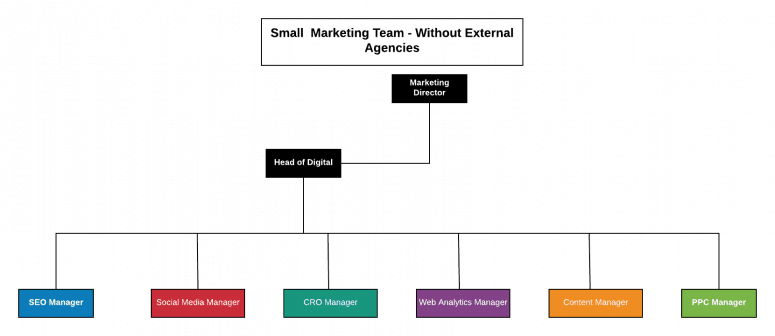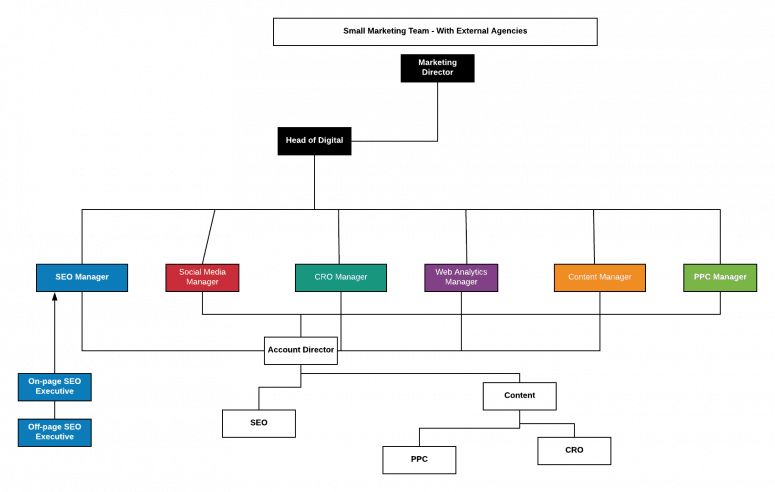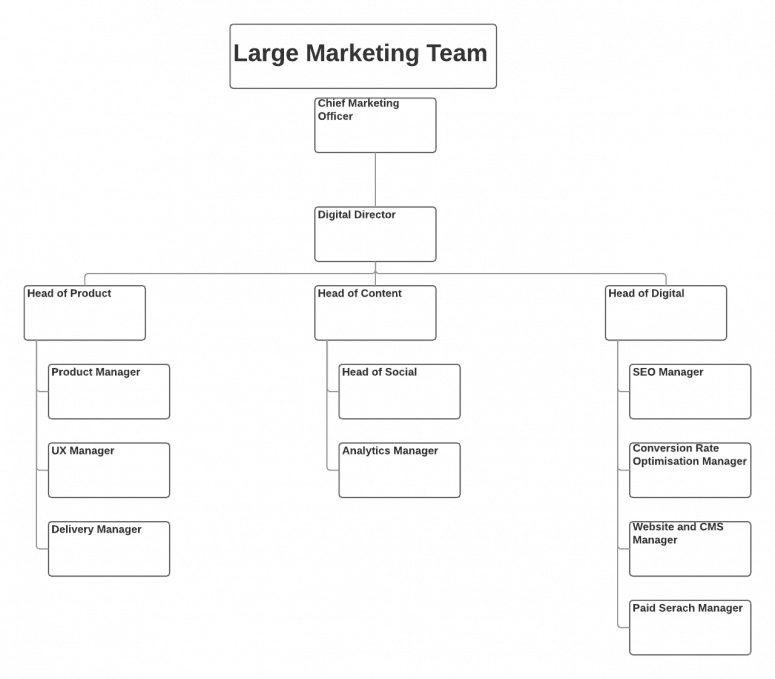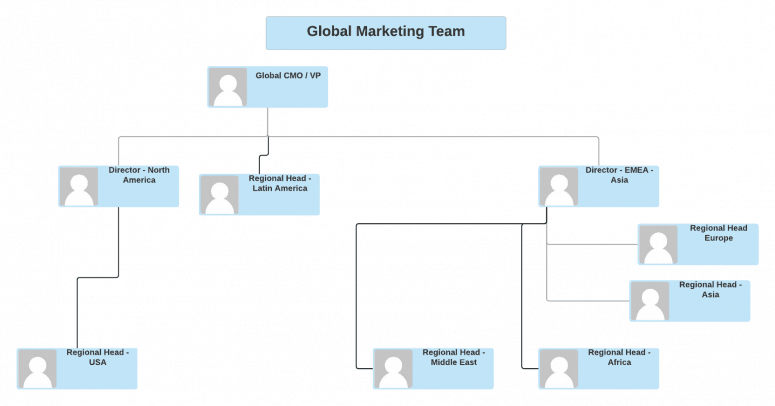Agile Marketing Team Structure
Agile Marketing Team Structure. What is the optimal structure of an Agile marketing team?
Table of Contents
Are you a team player? This question makes the theme of every interview process and is the no.1 determining factor behind every new hire. Imagine going into an interview and asking the hiring manager the reverse of the same question in the following series:
- Do you have defined team goals and objectives?
- How does your team embrace diversity of thought, gender, race and sexuality?
- Will I have authority to make decisions based on my experience and expertise?
Asking an interviewer these types of questions will most likely reduce your chances of getting an offer. So what is it that makes it impossible to ask these types of questions in an interview and why might a hiring manager take offence if an interviewee asked such question? There is currently a lack of clarity regarding the definition of a team and how it differs from a group, department or even a project team. If the definition of a team is not clear, then what do people visualise when they ask/are asked the question: “Are you a team player?”
Depending on whom you ask, you will probably get a different definition of a team. IT software companies using the Scrum framework will expect a team to have the following characteristics by default:
- Not less than 3, and not more than 9 people in total.
- Co-located in the same office for effective face to face communication, as recommended by the 2001 Agile manifesto for software development.
- Defined team roles of Product Owner, Scrum Master and Development team.
- Limited interference from external stakeholders – the Scrum master is responsible for protecting the team.
You can research more about Scrum teams in the IT software industry if you would like to know more, the list above is a brief summary and one of the reasons why I do not recommend applying Scrum to marketing without major revisions: marketing is already siloed and adding a framework that was developed for product development will do more harm than good. Now let’s focus on Agile marketing teams.
Agile Marketing Team Structure
When I think of a marketing team, I am not interested in the number of individuals or functional silos involved. All I care about is customer acquisition, conversion, retention, and customer lifetime value, as well as how all this links to excellent customer experience. I use the word team to identify a group of individuals responsible for end-to-end customer experience. The end-to-end customer journey is beyond marketing alone which is why marketing is now the responsibility of everyone in your organisation. Although some senior managers do not really like to hear this, the earlier this message is transmitted from the CEO to the entire organisation, the better results the organisation will achieve. So what does an Agile marketing team structure look like and what does it all mean for you?
An Agile marketing team structure can be defined as a group of individuals with complementary skills required to plan and execute marketing campaigns, using lean and Agile processes to increase the speed and efficiency of task completion. Research shows that the optimum number for a high-performance team is 5 people, however, this does not mean you are restricted to that number. As mentioned earlier, not less than 3 people and not more than 9 is the recommended team size for Agile – so play around with it as it suits your organisation.
It is important for marketing teams to understand that there can be different types of teams, as defined by their purpose:
Project teams: I mentioned Scrum teams earlier because they are what I consider to be project teams due to the fact that they have a fixed start and end date, which means a group of people is assembled for the primary purpose of delivering a piece of software or a product as its main objective. This team is stable by default until the end of the project and this structure describes well product development teams. A good example of a project team is when a CMO assembles a group of people to redesign the company website or organise a B2B event. Members of such teams are project focused even if they are together for only 6 months or for 2 years.
Stable Teams: I use this term in the context of marketing to describe an in-house marketing team which is made up of company employees and which excludes contractors and temporary workers. If you have been working with an external agency that you have a stable relationship with, then this would fall into the same category of team. Now let’s review real-life examples of team types and structures which pose challenges to marketing effectiveness.

Some marketing teams choose not to outsource any of their campaign planning or execution to external agencies due to bad experiences, lack of adequate budget or because they simply prefer increasing their internal capabilities. All members of this type of teams are usually collocated in the same building, which fosters face to face communication – a vital ingredient of effective Agile marketing team structure. Depending on the leadership style and the culture of your team, small teams (up to 5 members) could be considered the perfect size for implementing Agile marketing. It is important to acknowledge that there are advantages and disadvantages of not to working with external agencies.
Those of you working with external agencies might want to review a slightly different team structure below.

Some external agencies are now starting to adopt Agile ways of working in order to deliver value to their clients which is a very positive development in my opinion. Stability is an important factor in becoming an Agile marketing team. Having a high turnover rate reduces a team’s ability to become high-performing and effective. If your internal team is stable, can you say the same about the staff turnover in the external agency you are collaborating with? The arrival and departure of individuals impact team dynamics positively if the person leaving is toxic and negatively if you are losing a highly skilled individual due to office politics and power plays. Some questions to consider would be:
- How do we increase access to strategic level information?
- How do we manage task dependencies within the team and with external stakeholders?
Next, let’s examine larger teams.

I sometimes wonder why large marketing teams are often structured in a way that negatively impacts collaboration, interactions, and Agility. The organisational chart above is not theoretical in any way, it reflects what happens in real life where teams are structured based on political muscle to the detriment of customer experience. Now imagine UX, Analytics, Content, Paid Search and Social media all hiring different external agencies reporting directly to the managers, with each agency executing a different type of marketing campaigns without any knowledge of how this will impact the activities of others. Then they all rely on web analytics and other software tools to provide attribution modeling in order to facilitate decision making. On top of that, you also have the CRM system that is owned by another part of the organisation that does not even talk to other functions. Let’s look at the structure of a global marketing team before I share my thoughts about how to structure a large Agile marketing team.

The structure of global teams with head offices in North America is difficult because of the difference in time zone, culture and language. How do you structure a global marketing team to adopt an Agile way of working? How do you improve collaboration and interactions between team members that are co-located in your regional office with others working virtually 100% of the time? This is easier to manage if you have a single product, but gets more complicated if you have multiple product lines targeting different regions of the world. With increasing threat of small startups, large marketing teams will have no choice but to become Agile and how they structure their teams will determine how they are able to compete to survive. The same principles related to smaller teams (discussed above) also apply to large teams.
Agile marketing Team Structure: Recommendations
As a CMO, Director or Manager, the first question to ask yourself is “How do I structure my team to become Agile?”. Depending on where you search for answers or whom you ask, you are likely to get framework-related suggestions which can be dangerous in the long term. Large banks in the UK have paid out millions of pounds in a bid to become Agile without experiencing any discernible changes. They hire Agile coaches for a few months and everything seems to be working well while the coaches are present on-site, but as soon as they are out the door people revert back to their old ways of working. The first step to creating an Agile team is to understand that frameworks and processes alone will not help you.
There is no silver bullet or playbook to creating an Agile marketing team structure. Almost everyone in the marketing department has the motivation to climb the corporate ladder and become a CMO at some point. The individualistic format of performance reviews based on someone’s subjective interpretation of what you were able to achieve over the designated 12-month period creates an unhealthy competition within marketing teams and drains trust. You have to be brutal and politically savvy to get to the top of the tree and this contradicts with what is needed to lead Agile marketing teams. No matter how many people you had to throw under the proverbial bus to get to the top, you can still embrace Agile marketing team structure to get the most of out of your team. My recommendation is that you hire a team coach to assist you to create a culture of high performance and focus on finding someone who is passionate about upskilling you, as a team manager, to be able to seamlessly take over after they leave.
Also, bear in mind that people work in different ways due to differences in their background and personality types. Therefore, it would be counter-productive to impose a particular framework top-down on everyone in a bid to create an Agile marketing team. The leading approach emphasises a slow and careful improvement of your people, processes, and strategy. There are 5 important questions to consider when creating an Agile marketing team:
- As a leader, how do I create an environment of trust and respect within my team?
- How do I create a culture of continuous improvement?
- What problems are we currently facing due to the structure of our team and what needs to change?
- How should we manage task dependencies within the team?
- How do we eliminate Silos?
You have probably heard that Agile is a mindset that is required by everyone if you want to become an Agile marketing team. So what does ‘Agile mindset’ really mean? How do you get a group of individuals with different backgrounds, values and belief systems to change their mindset? The assumption that the mindset of a team will change if they adopt an Agile process or framework is not realistic. So the question you should be asking is “How does a team develop an Agile mindset?”. Creating a shared vision and clear definition of a ‘customer experience mindset’, is what marketing teams require. How do you create a customer experience mindset when most marketing teams don’t have a clear profile of their customers apart from the flawed customer insight from web analytics tools? If analytics tools were as great as we all think, would companies like Maplin and Toys R Us go bust? Surely they had the financial means to install enterprise software tools but these tools alone don’t provide insights about actual customer experience and what influences their purchasing behavior.
I am not suggesting eliminating hierarchies or redesigning your organisational structure completely, because I personally don’t believe that will change anything. The head of the team or marketing department is expected to be the smartest person and responsible for making strategic level decisions for the entire marketing function. Such approach was effective in the 1950’s before the internet era because C-Level people had the best education and skills for success and all they needed to do was command-and-control everyone working under them to execute strategies passed down the hierarchy.
Currently, the most valuable people in any organisation are the customer-facing employees because they have access to customer experience insights needed by the CMO and other senior stakeholders in order to make strategic decisions. As a team leader, how do you plan to tap into the knowledge of your team? It’s ok not to know everything and ask for help, but most leaders do not want to feel vulnerable by asking for help because they hold on to the assumption that they are expected to be the smartest person in the room. The good news is that you can use some Agile rituals to tap into the wisdom of your team if they are implemented properly.
Can marketing teams be structured like teams at Spotify?A lot has been spoken and written about how teams are structured in Spotify, but it is important to understand that these teams started by using the Scrum framework and realised its limitation before creating a structure that works in the context of their organisation. Spotify teams, also known as “squads”, are structured to minimize handoffs and waiting time between teams, which is the exact opposite of what we are trying to achieve in marketing teams. Also, the idea behind the Spotify team model centres around autonomous teams which are able to make decisions internally because they have all the skills required to execute any plan within the team. Marketing teams, in comparison, rely heavily on external stakeholders and agencies to execute campaigns and we don’t always have all the skills we need internally within the team, so there are obvious limitations here.
Finally, I’d like to end with a few questions to CMOs and other marketing team leads looking to embrace Agile:
- How do you plan to structure your team (or teams) to focus on outcomes and not outputs?
- How will you improve alignment between your functional teams?
- How will you improve the marketing department’s collaboration with external stakeholders in order to improve your overall customer experience?
Agile marketing Team Structure – Skill Requirement
Depending on your industry and location, there are a few important skills that you need when designing your Agile marketing team structure. I recommend having a conversion rate optimisation and web analytics consultant as the key skill that manages your end to end customer purchase journey while other channels work around these individual or sub teams.
Answer these questions for yourself and to will be well on your way to implementing Agile within your team!
